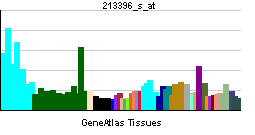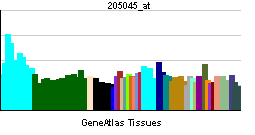AKAP10
| A kinase (PRKA) anchor protein 10 | |||||||||||
|---|---|---|---|---|---|---|---|---|---|---|---|
| Identifiers | |||||||||||
| Symbols | AKAP10 ; D-AKAP2; MGC9414; PRKA10 | ||||||||||
| External IDs | Template:OMIM5 Template:MGI HomoloGene: 32452 | ||||||||||
| |||||||||||
| RNA expression pattern | |||||||||||
 | |||||||||||
 | |||||||||||
| More reference expression data | |||||||||||
| Orthologs | |||||||||||
| Template:GNF Ortholog box | |||||||||||
| Species | Human | Mouse | |||||||||
| Entrez | n/a | n/a | |||||||||
| Ensembl | n/a | n/a | |||||||||
| UniProt | n/a | n/a | |||||||||
| RefSeq (mRNA) | n/a | n/a | |||||||||
| RefSeq (protein) | n/a | n/a | |||||||||
| Location (UCSC) | n/a | n/a | |||||||||
| PubMed search | n/a | n/a | |||||||||
A kinase (PRKA) anchor protein 10, also known as AKAP10, is a human gene.[1]
The A-kinase anchor proteins (AKAPs) are a group of structurally diverse proteins, which have the common function of binding to the regulatory subunit of protein kinase A (PKA) and confining the holoenzyme to discrete locations within the cell. This gene encodes a member of the AKAP family. The encoded protein interacts with both the type I and type II regulatory subunits of PKA; therefore, it is a dual-specific AKAP. This protein is highly enriched in mitochondria. It contains RGS (regulator of G protein signalling) domains, in addition to a PKA-RII subunit-binding domain. The mitochondrial localization and the presence of RGS domains may have important implications for the function of this protein in PKA and G protein signal transduction.[1]
References
Further reading
- Lester LB, Scott JD (1997). "Anchoring and scaffold proteins for kinases and phosphatases". Recent Prog. Horm. Res. 52: 409–29, discussion 429-30. PMID 9238861.
- Michel JJ, Scott JD (2002). "AKAP mediated signal transduction". Annu. Rev. Pharmacol. Toxicol. 42: 235–57. doi:10.1146/annurev.pharmtox.42.083101.135801. PMID 11807172.
- Epplen C, Epplen JT (1994). "Expression of (cac)n/(gtg)n simple repetitive sequences in mRNA of human lymphocytes". Hum. Genet. 93 (1): 35–41. PMID 7505766.
- Huang LJ, Durick K, Weiner JA; et al. (1997). "D-AKAP2, a novel protein kinase A anchoring protein with a putative RGS domain". Proc. Natl. Acad. Sci. U.S.A. 94 (21): 11184–9. PMID 9326583.
- Wang L, Sunahara RK, Krumins A; et al. (2001). "Cloning and mitochondrial localization of full-length D-AKAP2, a protein kinase A anchoring protein". Proc. Natl. Acad. Sci. U.S.A. 98 (6): 3220–5. doi:10.1073/pnas.051633398. PMID 11248059.
- Hamuro Y, Burns L, Canaves J; et al. (2002). "Domain organization of D-AKAP2 revealed by enhanced deuterium exchange-mass spectrometry (DXMS)". J. Mol. Biol. 321 (4): 703–14. PMID 12206784.
- Strausberg RL, Feingold EA, Grouse LH; et al. (2003). "Generation and initial analysis of more than 15,000 full-length human and mouse cDNA sequences". Proc. Natl. Acad. Sci. U.S.A. 99 (26): 16899–903. doi:10.1073/pnas.242603899. PMID 12477932.
- Kammerer S, Burns-Hamuro LL, Ma Y; et al. (2003). "Amino acid variant in the kinase binding domain of dual-specific A kinase-anchoring protein 2: a disease susceptibility polymorphism". Proc. Natl. Acad. Sci. U.S.A. 100 (7): 4066–71. doi:10.1073/pnas.2628028100. PMID 12646697.
- Gisler SM, Pribanic S, Bacic D; et al. (2004). "PDZK1: I. a major scaffolder in brush borders of proximal tubular cells". Kidney Int. 64 (5): 1733–45. doi:10.1046/j.1523-1755.2003.00266.x. PMID 14531806.
- Burns-Hamuro LL, Barraclough DM, Taylor SS (2005). "Identification and functional analysis of dual-specific A kinase-anchoring protein-2". Meth. Enzymol. 390: 354–74. doi:10.1016/S0076-6879(04)90022-5. PMID 15488188.
- Gerhard DS, Wagner L, Feingold EA; et al. (2004). "The status, quality, and expansion of the NIH full-length cDNA project: the Mammalian Gene Collection (MGC)". Genome Res. 14 (10B): 2121–7. doi:10.1101/gr.2596504. PMID 15489334.
- Rual JF, Venkatesan K, Hao T; et al. (2005). "Towards a proteome-scale map of the human protein-protein interaction network". Nature. 437 (7062): 1173–8. doi:10.1038/nature04209. PMID 16189514.
- Tingley WG, Pawlikowska L, Zaroff JG; et al. (2007). "Gene-trapped mouse embryonic stem cell-derived cardiac myocytes and human genetics implicate AKAP10 in heart rhythm regulation". Proc. Natl. Acad. Sci. U.S.A. 104 (20): 8461–6. doi:10.1073/pnas.0610393104. PMID 17485678.
| This protein-related article is a stub. You can help Wikipedia by expanding it. |